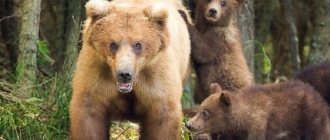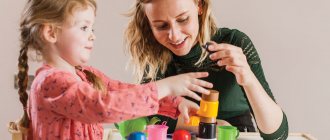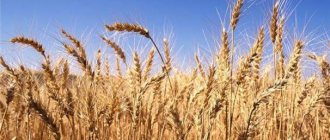Working with five-year-old children is a pleasure. And if until the age of 5 the child still resisted preparing for school, then from this age he dreams of growing up as quickly as possible and becoming a student. Now new knowledge and skills have been discovered, and the maturity of mental functions allows one to concentrate on a task for quite a long time.
In developmental classes, children aged 5-6 years master writing, arithmetic operations, and learn to recognize all the sounds in words. This is also the best time for learning to read; preschoolers study letters with interest and quickly grasp the principle of merging them into syllables.
However, the entire learning process should still be built on gaming activities, and the classes themselves should be distinguished by the variety of tools used. Otherwise, “tedious” lessons will only bring irritation, and the baby will lose interest.
Tasks for the development of logical thinking
Game "Who Lives Where?" Materials: cards with animals or animal figurines, drawings of three houses or cubes of different colors (three cubes). First, the child needs to be told that animals lived in the forest: a wolf cub, a hedgehog and a squirrel. The squirrel's house is neither red nor green, and the hedgehog lives neither in a red nor in a brown house. Then the child is asked to distribute the animals into houses and guess who lives in which house.
Tasks “What is higher?” Three trees grew at the edge: Spruce, maple and poplar. The maple is taller than the spruce, and the spruce is taller than the poplar. It is necessary to determine which tree is the shortest and which is the tallest. Then you can draw these trees.
Tasks “I wished for...” You need to wish for some object, and the child, with the help of questions, needs to guess what is wished for. For example: - Does this object float? -Yes. -Does he have an anchor? -No. -Is this an animate object? -Yes. -Is this a person? -No. -Does it have gills? -Yes. -This is a fish? -Yes.
Tasks “Distribute correctly” Materials: 26 cards with pictures of people. The people on the cards should be different, their hair color, length, eyes, and facial expressions should be different.
The child is asked to put people in different rooms: in one room - only men, in another - everyone with long hair, in the third - everyone with a joyful expression on their faces, in the fourth - only children. Then you can talk with your child about which people did not enter any room, and which people are suitable for not one room, but two or three.
Game “Dispersal of Birds” Materials: 20 pictures with drawings of birds. Only all birds must be different: domestic, migratory, predatory, songbirds. The child is asked to place all the birds in their nest houses: only migratory birds are placed in one nest, those with a long beak in the other, and those with black feathers in the third. Then you need to talk to the baby, who is left without a house? And who can be sent to different nests at once?
Tasks “Put the pictures in their place” Materials: cards with pictures of places that the child knows well. For example: buffet, desk, refrigerator, wardrobe. And cards with pictures of objects that can be put in these places. The child must first look at all the cards and then put things in their places.
Game "Who needs what?" Materials: pictures of people in various situations. For example: standing in the rain, brushing your teeth, sweeping the floor. And pictures with objects that correspond to the situation. The child needs to match the picture with the situation to the desired picture with the object. And then give an explanation for your choice.
Tasks “Make a figure from sticks according to the model” Materials: counting sticks and pictures with drawings of the model. The child is given a sample and must use chopsticks to make a shape on it. As a sample, you can choose a house, a flag, or geometric shapes.
Tasks “Name in one word” A number of words are read to the child, and he must summarize them. For example: Wolf, hedgehog, tiger, elephant (animals); bedside table, wardrobe, sofa, table (furniture); sweater, skirt, dress, pants (clothing); sausage, milk, loaf, cottage cheese (products).
Game “Say the other way around” Materials: ball or soft toy. An adult throws a ball or toy to the child and says a word. The child is asked to name a word with the opposite meaning. For example: hard - soft, cold - hot, child - adult, new - old, dirty - clean, white - black, thin - thick, light - heavy, full - empty, student - teacher, deep - shallow, kind - evil, cheerful - sad, blind - sighted, first - last, beautiful - scary, cowardly - brave, wide - narrow.



